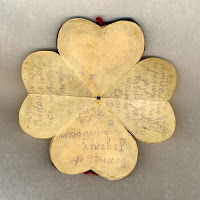
"The Heart of Auschwitz" is a small handmade booklet in the shape of a heart, on display at the Montreal Holocaust Memorial and Center. It has been made by a group of former Auschwitz female inmates for the 20th anniversary of their friend Fania Landau, on December 12th, 1944. Those girls were forced laborers at the Union Metalwerks factory in Auschwitz, which was manufacturing explosives and ammunitions. They were working 12-hours shifts, in the harshest conditions. Nonetheless, when a girl among their team named Zlatka Sznajderhaus came up to them with the idea of doing something special for Fania's birthday, they all joined in.
In the small booklet cut and tied together by Zlatka, each one of them added a special wish for Fania. The gift was given to Fania along with a small birthday cake made from their daily bread ration. It became Fania's most precious possession. She achieved in keeping it with her, through the Death March, in Ravenbrück and Malchöw, and when she resettled in Canada. A few years ago she donated the book to the Montreal Holocaust Memorial and Center, where it sits today in a glass case.
This inspiring story will be told in a documentary film currently produced by Ad Hoc Films, a Montreal (Canada) production company. This film will be broadcast by Canadian public television in 2009.
For the purpose of this film, an extensive research has been launched a few months ago in Europe, America and Israel to retrace those women who signed in the Heart. What makes this task extremely complicated is that, as we would do ourselves when addressing a friend, they only signed with their first names...
So far, this research has been conducted on several different levels, with historians, at institutions such as USHMM in Washington or with Yad Vashem in Israel and other national and local museums and associations. But nothing can replace individual knowledge, or friends and family networks.
We need all available help to locate these women. Would you happen to know a former female forced laborer in Auschwitz? Do you know an ex-Auschwitz inmate bearing or having bore one of the first names listed below? - keep in mind that many people changed their name with emigration. If you are interested in helping us further, you can also send the link to this site to people you know, or to associations and groups.
We are also interested in getting in touch with those women's families, or with other former Union forced laborers.
Feel free to contact us at adhocfilms@gmail.com, if you need further information, or if you think you might know something helpful. You will also find our full address in the "about Ad Hoc Films and Catherine Pelchat" section. Even tiny bits of information can lead to an essential breakthrough!
You can also leave a comment, if you wish.
With our deepest gratitude,
Catherine Pelchat
AD HOC FILMS
In the small booklet cut and tied together by Zlatka, each one of them added a special wish for Fania. The gift was given to Fania along with a small birthday cake made from their daily bread ration. It became Fania's most precious possession. She achieved in keeping it with her, through the Death March, in Ravenbrück and Malchöw, and when she resettled in Canada. A few years ago she donated the book to the Montreal Holocaust Memorial and Center, where it sits today in a glass case.
This inspiring story will be told in a documentary film currently produced by Ad Hoc Films, a Montreal (Canada) production company. This film will be broadcast by Canadian public television in 2009.
For the purpose of this film, an extensive research has been launched a few months ago in Europe, America and Israel to retrace those women who signed in the Heart. What makes this task extremely complicated is that, as we would do ourselves when addressing a friend, they only signed with their first names...
So far, this research has been conducted on several different levels, with historians, at institutions such as USHMM in Washington or with Yad Vashem in Israel and other national and local museums and associations. But nothing can replace individual knowledge, or friends and family networks.
We need all available help to locate these women. Would you happen to know a former female forced laborer in Auschwitz? Do you know an ex-Auschwitz inmate bearing or having bore one of the first names listed below? - keep in mind that many people changed their name with emigration. If you are interested in helping us further, you can also send the link to this site to people you know, or to associations and groups.
We are also interested in getting in touch with those women's families, or with other former Union forced laborers.
Feel free to contact us at adhocfilms@gmail.com, if you need further information, or if you think you might know something helpful. You will also find our full address in the "about Ad Hoc Films and Catherine Pelchat" section. Even tiny bits of information can lead to an essential breakthrough!
You can also leave a comment, if you wish.
With our deepest gratitude,
Catherine Pelchat
AD HOC FILMS



